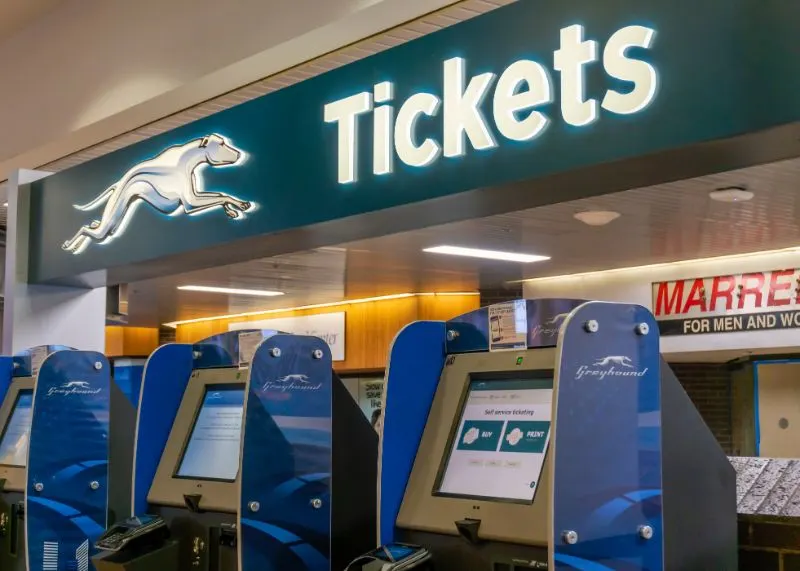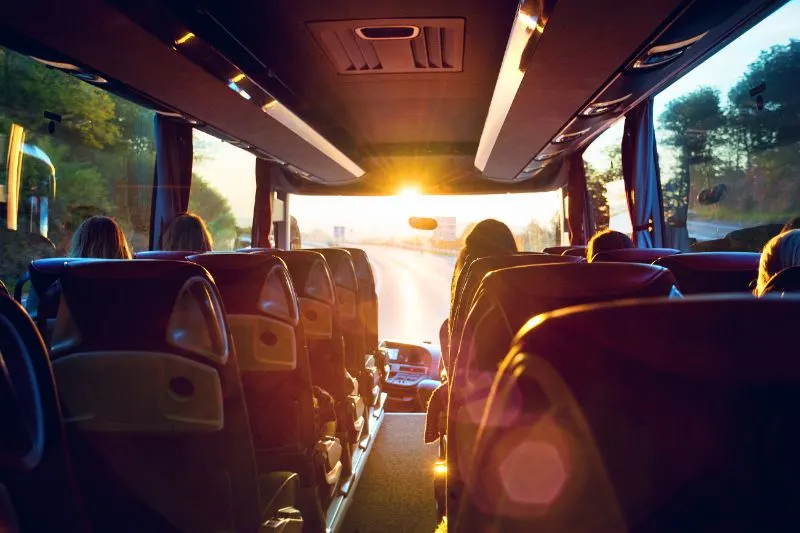Imagine you’re about to embark on a journey and the choice between bus or train travel has left you in a conundrum. Both are formidable options, steeped in their unique allure and functionality. Yet, how do you decide?
This post aims to decode the intricate tangle of advantages and drawbacks each mode of transportation carries. So fasten your seatbelt or secure your rails because we’re diving into an intense clash; Bus vs bus or Train ride together: the ultimate duel for travel superiority!
When comparing bus and train travel, both options have their advantages. While trains tend to be quicker on longer routes and offer spacious seating with scenic views, buses provide greater flexibility with frequent services throughout the day and are more affordable.
Ultimately, the choice between bus or train travel depends on personal preferences, time constraints, budget, and the specific route being considered. It is recommended to weigh these factors and prioritize the ones most important to you when making a decision.
Table of Contents
Financial Aspect of Train vs Bus Travel

When considering the financial aspect of train versus bus or plane travel, there are several factors to take into account. Let’s dive into these aspects and examine how they can impact your decision-making process.
One important consideration is the initial ticket cost. Generally, bus tickets tend to be more affordable compared to train tickets. This can be particularly beneficial if you’re on a tight budget or looking for the most economical option. Bus fares often vary based on routes and distances traveled, allowing you to choose a ticket that aligns with your budgetary constraints.
For instance, if you’re planning a short trip from one city to another within a state, a bus fare may cost around $25-$50, depending on the distance. On the other hand, train fares for the same route might range from $50-$100 or more.
However, it’s important to consider additional expenses that may arise during your journey. While train tickets may be pricier upfront compare bus one, trains generally offer more amenities and comforts than buses. These can include spacious seating, power outlets for charging devices, onboard Wi-Fi, and dining options depending on the train service chosen. Buses may provide only basic essentials like reclining seats and limited onboard facilities.
It’s also worth noting that train stations are often located in central areas of cities or towns, making them easily accessible and eliminating the need for additional transportation costs once you arrive at your destination.
On the other hand, bus stations can vary in terms of accessibility and proximity to key locations. This can necessitate spending additional money on taxis or public transportation to reach your final destination.
Now that we’ve explored the financial considerations of train versus bus travel let’s move on to comparing ticket costs between the two modes of transportation. When considering the financial aspect of train versus bus travel, it is important to take into account factors such as the initial ticket cost, additional expenses during the journey, and the accessibility of train and bus stations.
While bus tickets tend to be more affordable upfront, trains often offer more amenities and comforts. Additionally, train stations are usually centrally located, eliminating the need for extra transportation costs upon arrival. It is crucial to weigh these factors when making your decision.
See Related: The Best Time of Day to Travel by Bus: A Guide for Savvy Travelers
Ticket Costs Comparison

Comparing ticket costs between trains and buses can provide valuable insights into which option is more budget-friendly. While bus fares are generally lower, it’s important to evaluate the overall value you receive for the price.
Bus ticket costs tend to vary based on factors such train routes such as distance, departure time, and booking methods. Often, buying tickets online in advance can yield discounted rates compared to purchasing them at the station right before departure. This allows you to secure a lower fare and potentially save money.
Think of it like planning a vacation. Booking flights months in advance usually results in a more affordable fare than last-minute purchases. The same principle applies to bus travel.
On the other hand, train ticket costs may be higher upfront, but they often come with added benefits such as more comfortable seating options, larger and cleaner facilities, and faster travel times. Additionally, some train services offer various fare classes or discounts for specific demographics like students or seniors. These discounted rates can offset the initial higher cost and make train travel a more financially viable option.
It’s important to note that popular bus routes for both trains and buses occasionally offer promotional deals and discounts throughout the year. Checking websites or signing up for newsletters from major transportation providers can help you stay informed about any upcoming offers that could further reduce ticket costs.
It ultimately comes down to your personal priorities and preferences. If you prioritize cost-saving without compromising on comfort or if you have a limited budget for transportation, buses may be the better choice. On the other hand, if you value amenities, convenience, and potentially faster travel times, then investing in train tickets might be worth considering, even if they come with a higher price tag.
- According to the U.S Department of Transportation data from 2021, on average, long distance trains produce about 0.17 kg of CO2 per passenger mile, whereas buses emit about 0.08 kg per passenger mile – making buses more environmentally friendly.
- The Bureau of Transportation Statistics reported that in 2022, about 60% of intercity travelers preferred buses for journeys under 250 miles, citing cost and flexibility as primary reasons.
- A study from the American Public Transportation Association in 2023 indicated that the median travel time on buses was roughly equivalent to that of trains for medium-length journeys (100-400 miles), while trains had a slight edge for longer-distances due to higher speeds and priority assistance from traffic management.
Time Efficiency and Scheduling of Trains and Buses

When it comes to choosing between trains and buses for travel, considering the time efficiency and scheduling plays a crucial role. Trains are often seen as a faster mode of transportation due to their ability to operate at higher speeds on dedicated railway tracks.
This can be especially advantageous when traveling long distances or between major cities. For example, a train journey from New York City to Boston might take just a few hours, while the same distance covered by bus could take significantly longer.
In terms of scheduling, trains generally adhere to set timetables, offering passengers more predictability and convenience in planning their journeys. These schedules are meticulously designed with regular departures and arrivals, allowing travelers to better manage their time. Additionally, trains often provide online platforms or mobile applications where passengers can easily access schedules, purchase tickets, and make seat reservations in advance. This helps to streamline the travel process and avoid any last-minute inconveniences.
However, it is important to note that train schedules may be subject to delays or disruptions due to various factors such as weather conditions or mechanical issues. While these instances are not common, they can still impact the overall time efficiency of train travel. It is advisable for passengers to stay updated with any announcements or alerts provided by the railway authorities.
On the other hand, buses also offer train wheels their own advantages when it comes to time efficiency and scheduling. While buses generally operate at lower speeds compared to trains, they have the advantage of being more flexible in terms of routes. Buses can navigate through city streets or smaller towns that may not have direct train connections. This flexibility allows for more accessibility and convenience in reaching certain destinations that may not be directly serviced by trains.
Consider a scenario where you need to reach a small town located off the beaten path. In this case, taking a bus might be your best option since it can take you directly to your destination without the need to transfer to another mode of transportation.
Another aspect to consider is the frequency of bus service. Buses often have more frequent departures throughout the day, especially in urban areas. This can be beneficial for travelers who prefer not to be tied down to a specific departure time or need the flexibility of choosing when they want to travel.
While trains offer faster speeds and more rigid schedules, buses provide greater flexibility and frequent service options. The choice between the two modes ultimately depends on factors such as distance, accessibility, and personal preferences.
Punctuality and Frequency
Punctuality is a crucial factor to consider when deciding between bus and train travel. Trains typically have a higher reputation for punctuality compared to buses. Due to their dedicated tracks and fewer stops along their routes, trains are less susceptible to traffic congestion or delays caused by road conditions. This means that train passengers can rely on a more accurate arrival and departure schedule, minimizing wait times at stations and reducing the risk of missing connections.
For instance, if you have an important meeting or event that you cannot afford to be late for, opting for train travel might be the safer choice in terms of punctuality.
On the other hand, when it comes to frequency of service, buses tend to have an advantage over trains. Bus routes are often designed to cater to local commuters, offering more frequent departures throughout the day.
This allows passengers more flexibility in choosing their preferred travel times and reduces wait times at bus stops. Additionally, buses often have multiple stops along their route, providing more options for travelers looking for stops close to their desired destinations.
Let’s say you need to travel from your residential area in the city traffic the suburbs to your workplace in downtown. In this case, taking a bus with frequent departures might be more convenient and time-efficient, especially during rush hour when traffic congestion could significantly delay a train journey.
Punctuality and frequency are important considerations when choosing between trains and buses. While trains offer better punctuality with their dedicated tracks and stricter schedules, buses provide greater flexibility in terms of frequency and multiple stops along their routes.
See Related: Is Greyhound Bus Safe? Here’s What to Know
Comfort Levels on Trains vs Buses

When it comes to comfort levels, both trains and buses offer unique experiences that cater to different preferences. Let’s explore the factors that contribute to the overall comfort of each mode of transportation.
Trains have long been associated with a sense of romance and elegance. With their spacious seating arrangements and large windows, train travel provides passengers with a more relaxed and airy environment.
The wide seats and ample legroom allow for stretching out and finding a comfortable position during the journey. Furthermore, the smooth ride of trains, thanks to their dedicated tracks, minimizes turbulence and provides a stable platform for passengers to enjoy their trip comfortably.
On the other hand, buses have made significant strides in recent years in terms of passenger comfort. Many modern buses are equipped with features such as comfortable reclining seats, ample legroom, and even footrests.
Additionally, technology has played a role in enhancing the comfort level on buses by providing amenities like Wi-Fi connectivity, power outlets for charging devices, and onboard entertainment systems. These features make bus travel an attractive choice for those seeking additional convenience during their journey.
It’s worth noting that both a train ride and bus journeys can vary in terms of comfort depending on factors such as the specific train or bus operator and the duration of the trip. Longer train rides often provide more luxurious options such as sleeping compartments or dining cars, offering passengers a premium experience. Similarly, some long-distance buses may offer additional amenities like blankets or pillows to ensure passenger comfort during overnight travel.
Ultimately, the choice between trains and buses in terms of comfort will depend on personal preferences. Some individuals may value the elegant atmosphere and spaciousness offered by trains, while others may appreciate the convenience and modern amenities available on buses.
Now that we understand the varying comfort levels provided by trains and buses let’s move on to assessing the range of amenities offered by each mode of transport.
Amenities Assessment
When it comes to amenities, both trains and buses have adapted to modern travelers’ needs by offering a range of features to enhance the overall experience. Let’s compare the amenities provided by each mode of transportation.
Trains often excel in providing stunning views during the journey, especially on scenic routes. Passengers can enjoy picturesque landscapes and natural wonders passing by their windows, adding a touch of adventure and tranquility to their trip.
Additionally, some trains offer onboard dining services with a selection of meals prepared by professional chefs, allowing travelers to indulge in culinary delights while en route to their destination.
Buses, although limited in terms of panoramic views due to roads being at ground level, make up for it with other convenient amenities. As mentioned earlier, many buses now provide Wi-Fi connectivity, enabling passengers to stay connected and catch up on work or entertainment during their journey.
Power outlets are also commonly available onboard, ensuring that electronic devices remain charged throughout the trip. Furthermore, some luxury buses even offer comfortable seating configurations like reclining chairs or individual screens for each passenger.
It is important to note that while certain amenities are more commonly associated with one mode of transportation than the other, these offerings can vary between different various train lines and bus operators.
For example, not all buses may have Wi-Fi connectivity or power outlets, just as not all trains may have dining cars or panoramic windows. It’s essential to research the specific amenities provided by book bus and the operator you plan to travel with before making a decision.
Ecological Footprint and Safety Concerns

When considering the best mode of transportation for travel, it is important many travelers to take into account the ecological footprint and safety concerns associated with different options. Both buses and trains have their own advantages and disadvantages in these areas.
Ecological Footprint: One of the major concerns in today’s world is the impact of transportation on the environment. Buses generally have a higher ecological footprint compared to trains. This is due to factors such as the size of the engine, fuel efficiency, and the number of passengers they can carry.
Buses typically consume more fuel per passenger mile traveled compared to trains, resulting in higher carbon emissions. However, advancements in technology have allowed for the development of hybrid and electric buses that can significantly reduce their ecological impact.
Imagine Sarah, a traveler who often commutes between cities for work. She has to choose between taking a bus or a train. Sarah has an interest in reducing her carbon footprint, so she decides to research which option would be more environmentally friendly for her journey.
Safety Concerns: Another crucial aspect to consider is safety during travel. Both buses and trains have safety measures in place, but they differ in terms of risk factors and how incidents are managed.
Let’s take a closer look at buses. They are typically equipped with seat belts and follow traffic regulations like any other vehicle on the road.
However, bus accidents can occur due to various reasons, such as driver fatigue or negligence by other motorists on the road. Moreover, bus passengers may be at a higher risk of injury during accidents due to the lack of protective devices like airbags commonly found in cars.
Sarah understands that accidents can happen regardless of the mode of transportation she chooses. However, she acknowledges that understanding these potential risks allows her to make an informed decision regarding her safety.
On the other hand, trains have their own safety measures and considerations. Trains operate on dedicated tracks with limited interaction with other vehicles, reducing the risk of accidents caused by external factors. Additionally, trains are generally equipped with multiple safety features such as emergency brakes, surveillance systems, and well-trained staff to ensure passenger safety.
Having examined the ecological footprint and safety concerns associated with both buses and trains, let’s now turn our attention to the comparison of carbon emissions and safety measures between these two modes of transportation.
Carbon Emissions and Safety Measures Comparison
When comparing carbon emissions between buses and trains, it is important to consider various factors such as fuel efficiency and passenger capacity.
BusesTrainsCarbonHigher carbon emissions perLower carbon emissions perEmissionspassenger mile traveledpassenger mile traveledEfficiencyCan vary based on engineGenerally more fueltype (diesel/gas/electric)efficient than busesPassengerVaries depending on busCan accommodate a largerCapacitysizenumber of passengers
An important aspect to consider when comparing safety measures is the difference in infrastructure and the level of control. Buses rely heavily on road conditions and other drivers, while trains operate on dedicated tracks.
Therefore, when it comes to choosing the best mode of transportation for travel, individuals should consider their priorities regarding ecological impact and safety. While buses may have higher carbon emissions compared to trains, the development of technology in recent years has made way for more sustainable options. Regarding safety concerns, both modes have their own unique risks and countermeasures in place. It ultimately boils down to personal preference, journey requirements, and weighing the pros and cons of each option.
Related Resources:
